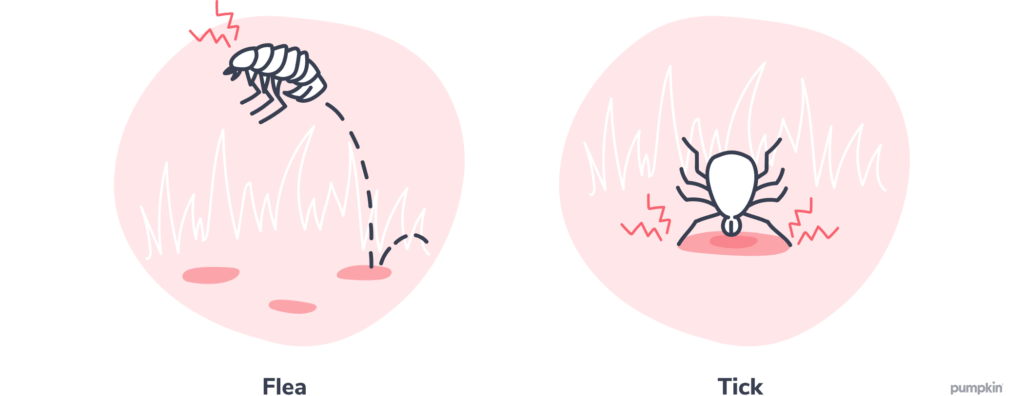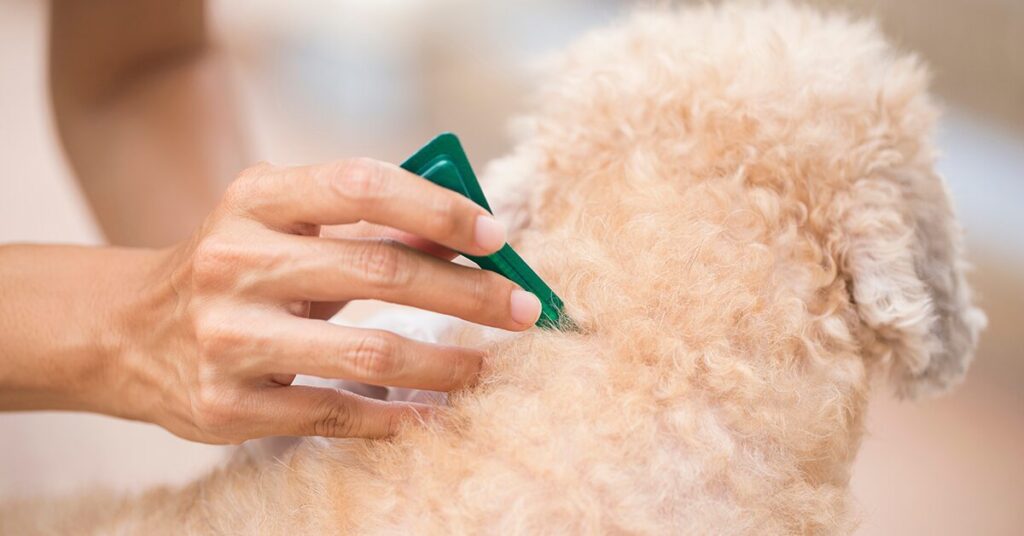- Pumpkin Team
- Aug 7
- 5 min read
Updated: Oct 30
Key Points
Flea prevention is an important part of keeping your dog healthy and comfortable.
Treatment options include oral meds, topical solutions, and flea collars — each with benefits depending on your dog’s needs and lifestyle.
Regular preventative measures and consistent use of treatments can effectively control and prevent fleas.
Is your pooch scratching a little too much lately? If so, fleas might be to blame. These pesky parasites can cause big problems for your dog, not to mention your home. For every pet parent, understanding the right flea prevention methods is key to keeping your dog comfortable and healthy.
So, what is the best flea prevention for dogs? Veterinarian-recommended options like topical treatments, oral medications, or flea collars are the most effective. This guide dives deep into the world of flea prevention for dogs, including how fleas spread, the pros and cons of different treatment options, and tips for protecting both your dog and your home.
What are fleas?
Fleas are small, flightless insects and external parasites that live on animals and feed on their blood. Despite their minuscule size at around 1 to 2 millimetres, fleas are powerful jumpers capable of leaping from one host to another in the blink of an eye. Fleas are reddish-brown with flat, wingless bodies, making it easy for them to hide in your dog’s fur.

If your dog has fleas, you might notice black, pepper-like specks on their skin, excessive scratching, or even catch sight of the fleas themselves. Left untreated, fleas can lead to skin irritation, allergic reactions, or in severe cases, anemia.
How do dogs get fleas?
Fleas spread easily and can infest pets in several ways:
Contact with other animals: Dogs can pick up fleas through contact with other pets or wildlife carrying the pests.
Outdoor exposure: Fleas thrive in outdoor environments like grassy parks, wooded areas, or backyards.
Infested objects or spaces: Fleas can hitch a ride home on bedding, carpets, or even second-hand furniture previously exposed to infested animals.
Fleas are not only a danger to dogs but may also bite humans and other pets, spreading discomfort and potential diseases to the entire household.
The best flea treatments for dogs
The best flea treatments for dogs are safe, effective, and also protect against ticks. Below are the top treatment options available:
1. Oral medications
Oral flea medicine for dogs is a highly effective flea treatment option, providing fast-acting relief that can last from one to three months, depending on the product. These medications work by entering the dog’s bloodstream, killing fleas when they bite. Common options from veterinarians include brands like NexGard, Bravecto, and Simparica.
They are convenient to administer, as they typically come in a chewable, flavored tablet that dogs enjoy. Regular dosing as directed by your veterinarian ensures continuous protection and prevents reinfestation.
2. Topical treatments

Topical treatments are a popular option for treating fleas and are applied directly to a dog’s skin, typically between the shoulder blades. These treatments provide month-long protection to effectively kill fleas. The treatment can also repel ticks, depending on the product. Frontline Plus, K9 Advantix II, and Advantage II are common brands recommended by veterinarians.
Topical treatments work by spreading across the skin’s surface and into the dog’s sebaceous glands. Benefits include ease of use and water resistance, allowing dogs to remain safe from fleas even during baths or rainy weather.
3. Flea and tick collars
Flea and tick collars are a convenient and long-lasting solution for pest control. They slowly release active ingredients that spread across the skin and coat, helping to repel and kill fleas and ticks.
Flea and tick collars often last several months, making them a cost-effective option. They are easy to use and require minimal maintenance, making them ideal for pet owners seeking a hassle-free approach to keeping their dogs protected from harmful parasites.
Holistic flea and tick prevention for dogs
Many pet parents seek natural remedies to prevent fleas and ticks on dogs, such as essential oils, herbal sprays, or diatomaceous earth. While these holistic methods may sound appealing, veterinarians caution against relying solely on them. Natural preventatives are often less effective and may not provide the level of protection your dog needs, especially in high-risk areas.
Fleas can also transmit diseases like tapeworms or Bartonella, which makes choosing proven, vet-approved preventatives a smarter choice. When in doubt, speak to your provider for recommendations tailored to your dog’s needs.
Does pet insurance cover flea medication?
Pet insurance typically covers accidents and illnesses, but does not include routine care like flea and tick medications. However, programs like the Pumpkin Wellness Club* can help you save up to $460 per year on routine care and more – including $150 for tick prevention?
Removing fleas from your dog
Prevention is always the best method for keeping your dog flea-free. Using reliable flea preventatives regularly, keeping your home clean, and grooming your dog often can greatly lower the chances of an infestation.
However, if your dog does get fleas, swift action is important. Removing fleas can be a little trickier than removing other pests like a tick because they’re a lot harder to see and an infestation can develop quickly.
Start by using a flea comb to remove fleas from their fur, focusing on areas like the neck and tail. You can bathe your dog with a flea shampoo to kill existing fleas. Be sure to select a flea treatment for dogs at home that will kill existing fleas as well as protect from others.
Removing fleas from your home
If your dog brings home these hitchhikers, getting them off your dog is the first step — but your home can be a culprit for further exposure. To deflea your home, start by thoroughly vacuuming all carpets, rugs, and furniture to remove fleas, eggs, and larvae. Dispose of the vacuum bag or empty the canister immediately outside to prevent reinfestation.
Wash all pet bedding, curtains, and linens in hot water. The hotter the better, but anything over 95°F will kill live fleas. Use flea sprays or insect growth regulators on carpets, baseboards, and hard-to-reach areas where fleas may hide. Consider steam cleaning carpets and upholstery for added effectiveness. For severe infestations, professional pest control services may be necessary.
Flea prevention is better than treatment

Flea prevention for dogs is not just about treating an infestation but taking proactive steps to prevent one in the first place. Whether you opt for oral flea prevention for dogs, topical treatments, or collars, there is a solution tailored to every pet and lifestyle.
Protect your furry companion and your home by starting regular flea prevention today. Find out how you can start saving on routine care, like flea prevention, with the Pumpkin Wellness Club.
FAQs
Why is flea prevention important for my dog?
Flea prevention is essential because fleas can cause severe discomfort, irritation, and allergic reactions in dogs. These pests may also transmit diseases and lead to anemia in severe infestations. Fleas quickly spread in your home, posing a risk to other pets and humans. Effective prevention keeps your dog healthy and your environment pest-free.
How often should I use flea prevention treatments?
The frequency depends on the type of prevention method you choose. Oral medications and topical treatments are typically administered monthly, while certain flea collars can last several months. Always follow the instructions provided by your veterinarian or the product manufacturer.
What is the safest flea prevention for dogs?
The best flea prevention for dogs often includes veterinarian-recommended treatments such as topical solutions, oral medications, or flea collars that are specifically designed for pets. Natural remedies, like regular grooming and using pet-safe essential oil sprays, may complement these methods.
*Pumpkin Wellness Club is marketed and administered by Sprout Wellness Services LLC (d/b/a “Pumpkin Wellness Club”). Pumpkin Wellness Club is not an insurance policy. It is offered as a standalone pet wellness membership program. For full terms, visit wellness.pumpkin.care/membership-agreement.



